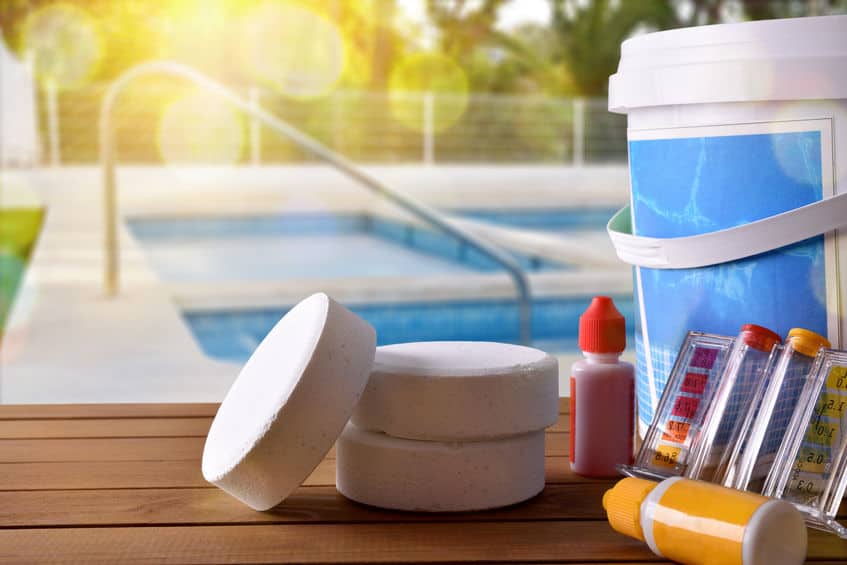Many new salt water pool owners are surprised to find out that their pool requires the same chemicals that regularly chlorinated pools do.
Plus, we need to add salt too of course! Regular pool owners don’t need to worry about that.
One chemical that you might not be familiar with that is particularly important to salt water pools is cyanuric acid which is also simply known as stabilizer or CYA.
If you don’t use stabilizer in your salt water pool, you will increase your chlorine requirements which places more stress on your salt cell and chlorinator. This will require a quicker replacement of both due to increased wear and tear.
As we’ll see below, stabilizer is particularly important to salt water pool owners due to the relatively low amount of chlorine that your chlorinator is capable of producing each day.
Quick Highlights
- Stabilizer helps to protect the chlorine from the sun so that it can be used for its intended purpose.
- Direct sunlight kills chlorine which increases your chlorine requirements.
- Chlorine is also used up by killing bacteria and contaminants that enter the pool when swimming.
- The more chlorine you require, the sooner your salt cell will need replacement.
- Salt water chlorinators produce chlorine at a slow but steady rate rather than providing a quick large dose.
- Salt water pools are more susceptible to algae than other pool types since chlorine is provided in small amounts over time.
Keeping your level of cyanuric acid in check is important to overall pool health, salt cell lifespan and crystal clean water. Let’s delve into more detail below!
Stabilizer requirements are higher in salt water pools for a reason
The ideal stabilizer range in a regularly chlorinated pool is usually suggested to be between 30 ppm and 70 ppm. In a salt water pool the ideal cyanuric acid level is 80 ppm. PPM stands for parts per million.
Why the difference?
Salt water pool chlorinators produce chlorine at a slow, steady rate. By having slightly more stabilizer in the water, it enables the chlorine residual to build up more effectively.
In a regularly chlorinated pool, chlorine products (crystals and pucks for example) normally have stabilizer included. So if you see Stabilized Chlorine on the packaging, that’s what they are referring to.
Every time you add stabilized chlorine to the water, you are adding chlorine and the chemical that helps protect it.
The chlorine produced by your salt water chlorinator is unstabilized. Salt water pool owners need to manually add the stabilizer ourselves and it’s normally in crystal form. By keeping the level of stabilizer higher, it increases the chance that your chlorine level will remain well within range even during sunny days.
Why keeping stabilizer within range is important for salt water pools
While you want to ensure you have enough stabilizer in your pool water, you also want to ensure you don’t have too much.
Too much stabilizer: Can render the chlorine in your pool less effective which you don’t want. If your stabilizer is consistently too high, it’s normally fixed by draining some water and adding fresh water. This can however knock your water chemistry out of balance so be careful.
Too little stabilizer: Can cause the chlorine that you have in your pool to die off from the damaging rays of the sun. You will probably have to add cyanuric acid at the beginning of the pool season and perhaps again in the middle of the summer especially if you’re getting very sunny days and/or have repeatedly topped up your water level due to evaporation, spillage, etc.
Summary
Cyanuric acid (CYA) or stabilizer is an important aspect of salt water pool maintenance and should be maintained at around 80 ppm at all times. Because your salt water chlorinator produces chlorine at a relatively slow rate, it’s important to protect the chlorine that you do have and that’s what stabilizer does.
Cyanuric acid is like sunscreen for your chlorine. While the sun’s direct rays deplete chlorine within a short period of time, CYA helps to extend its life. Keeping your level of stabilizer at 80 ppm ensures that chlorine can build up in your salt water pool to maintain nice crystal clean water.
One final note
The first thing my pool company told me when they first told me add some stabilizer to my salt water pool during spring opening was this:
Sprinkle it very slowly into the side skimmer because if you dump it in quickly or just toss it in the water, it can coagulate (bind together) and clog your pipes.
The stabilizer I have access to needs care when adding it to the water. The other suggestion my pool company made was to pour the necessary amount in an old pair of pantyhose, tie it at the top, and place it in the skimmer to slowly dissolve. I choose the first option and sprinkle it in slowly and haven’t any trouble.
Bottom line: Follow the manufacturer’s instructions when adding your stabilizer manually to your pool!

